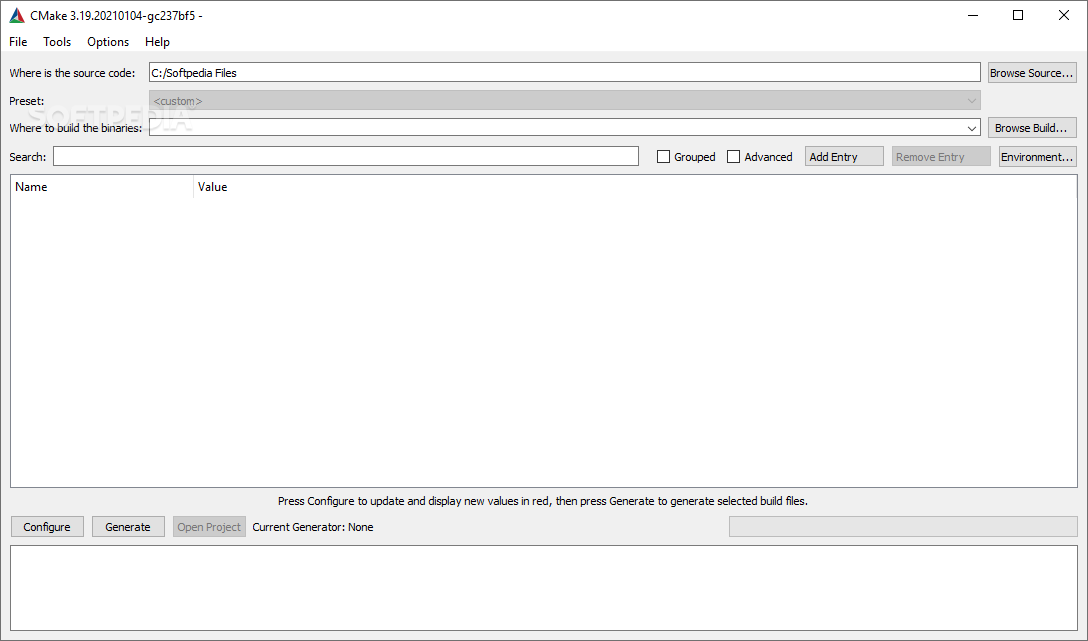
By default, ccmake only displays a part of the available cache variables. If you want to quit without generating, press 'q'. Once you are done, press 'c' to reconfigure the build, then press 'g' to generate the native build system and exit ccmake. A short help text to each variable is displayed at the bottom in a status bar. Otherwise you can type in the new value of the variable and press Enter again to finish your edit. If the variable is boolean, this will switch its state from ON to OFF or vice versa. Use the cursor keys to navigate to any variable you want to change, then press Enter. You are presented with UI which lets you edit the content. It processes the source directory and prepares the current directory as the build directory. If you are unsure about every variable that needs to be set, the ccmake command provides a sort of GUI that allows one to interactively see all varibles set by cmake as well as their values. If you need to assign multiple libraries, you can do it with -D='-L -l -l

#CMAKE FLAGS SOFTWARE#
If a compiler is not specified, cmake will default to /usr/bin/ which is not compatible with the rest of our software stack The \ character will continue a command on the next line so the above line is actually a single command with line breaks for readability

\ -DGMX_GPU=ON\ –DGMX_MPI=ON\ -DCMAKE_INSTALL_PREFIX=/home/ \. You can use this template for your package: CC=gcc \ CXX=g++ \ FC=gfortran \ CFLAGS=-O3 \ CXXFLAGS=-O3\ FFLAGS=-O3\ cmake\. At a minium you will usually need to specify which compilers you want cmake to use as well as the final installation path. The options below are for the GROMACS package (search for options in CMakeLists.txt file). Run cmake command with appropriate options. Output: CMAKE_INSTALL_PREFIX CMAKE_LIBRARY_PATH. See the CMake Variable List: cmake -help-variable-list Load the cmake modules: module load depends module load cmake If something goes wrong, the build directory can be deleted and recreated without impacting the original source code. It also stores several other files including its cache.Īdditionally, it is helpful to build with different build options. The compiler's output is stored here which includes both object files as well as final executable and libraries.
#CMAKE FLAGS CODE#
It's best practice to make a build directory to keep the original source code clean. cmake files which allow them to be easily found dependent software that also uses Cmake as a build system.
#CMAKE FLAGS INSTALL#
To change the location of the install directory from default /usr/local to home directory, use -DCMAKE_INSTALL_PREFIX=/home/ and to enable GPU and MPI on GROMACS package, use -DGMX_GPU=ON -DGMX_MPI=ON To change the content of the CMake Cache variable, use -D option after cmake command. For an example, to enable GROMACS package with MPI option, use GMX_MPI=ON. The options are presented in the form of variables which usually are of the form PACKAGE_ and may contain anything from BOOLEAN to strings. It provides options for user to customize the build process and specify paths to dependent software. When invoked, CMake parses these text files and generates a native build chain for the desired platform and compiler. The build process is described in a plain text file, traditionally named CMakeLists.txt. CMAKE Installation Brief procedure CC=gcc CXX=g++ FC=gfortran \ CFLAGS=-O3 CXXFLAGS=-O3 FFLAGS=-O3 \ cmake -DCMAKE_INSTALL_PREFIX=/home/ \ /path/to/CMakeLists.txt make make installĬmake is a cross platform build system.


 0 kommentar(er)
0 kommentar(er)
